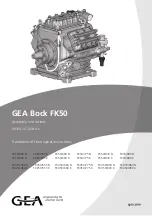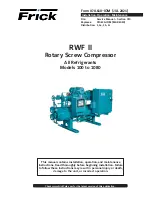
4.4.
stop the compressor by turning off the main switch (fig.3.1). The compressed air inside the compressor head will flow out, making the
restart easier and preventing the motor from being damaged.
DO NOT,
other than in an emergency
,
stop the compressor by switching
off the mains socket, or by pulling the plug out, as the pressure relief will not then occur and motor damage may result upon restart.
When the compressor runs correctly and is stopped correctly there will be:
(a) a whistle of compressed air when the motor stops,
(b) a protracted whistle (about 20-25 seconds) when the compressor starts with no pressure in the tank.
NOTE:
a) If the motor does not cut in and out, but runs continuously when using an air appliance, the capacity of the compressor may be too
small for the equipment or tool.
b) The gauge (fig.3.2) indicates the pressure inside the main tank, NOT the pressure supplied to the air equipment. should the pressure
in the tank exceed the pre-set switch (6) maximum, the safety valve (5) will activate.
WARNING! for this reason DO NOT tamper with, or adjust, the switch or safety valve.
In order to keep the compressor in good working condition, periodic maintenance is essential.
IMPORTANT! Failure to carry out maintenance tasks may invalidate the warranty on your compressor.
WARNING! Before performing any maintenance operation, switch off compressor, disconnect from power supply and vent air
from tank.
5.1.
After the first 50 working hours.
Operations to be carried out
:
a) Check that all bolts/nuts are tight, particularly those retaining the crank case and cylinder head (fig 4).
b) Replace the lubricating oil - see para 5.6.
5.2.
Daily.
Operation to be carried out :
a) Drain condensation by opening the drain valve (fig 5) located under the tank.
5.3.
Monthly (or more frequently, if the compressor operates in a very dusty atmosphere):
a) Check oil level and, if necessary, top up. b) Remove the filter element (fig.6.X) by unscrewing wing nut and lowering the air filter
cover. Clean by blowing through, with an air line at low pressure, from the clean side. Do not operate compressor without filter as
foreign bodies or dust could damage the pump. c) Check belt tension.
d) Check for oil leaks.
5.4.
3-monthly.
Operation to be carried out a) Check tank for internal corrosion.
5.5.
Every 500 hours.
Operations to be carried out :
a) Change air filter element
b) Check the automatic cut-out at max. pressure and the automatic cut-in at 2 bar below.
5.6.
Every
1000 hours.
Operations to be carried out :
a) Replace the lubricating oil. for oil specifications see 5.7.
Remove the oil breather (fig 7.A) and screw (B), draining the oil into a container. Drain when the compressor is hot so that oil drains
rapidly and completely. Wash breather in kerosene, fuel oil or similar. Replace screw ‘B’ and refill through the filler aperture.
Do not overfill. Replace breather.
WARNING! Never mix different oils and do not use non-detergent/low quality oils as compressor
may be damaged.
WARNING! Dispose of waste oil only in accordance with local authority requirements.
b) Check belt tension. A weight of 3kg applied at the belt mid-point should give a deflection of approx. 10mm (fig.8). If adjustment is
required remember to maintain the alignment of the two pulleys (fig.8). Adjust by repositioning motor.
c) Check all tube fittings and electrical connections.
d) Inspect pressure tank inside and out for damage or corrosion.
5. MAINTENANCE
fig. 4
fig. 7
fig. 5
fig. 6
5.7.
Recommended oils
Recommended oil for compressors, suitable for room
temperatures ranging from +5°C to +25°C:
sEALEY CPO or equivalent sAE 40 compressor oil.
Room temperature below +5OC: sAE 20 compressor oil.
Approximate oil capacity: 1.4 litres.
ALIGNMENT
fig. 8
fig. 9
Original Language Version
sA3015/55, sA3020/55, sA3027/75 Issue: 2 - 21/10/09






















